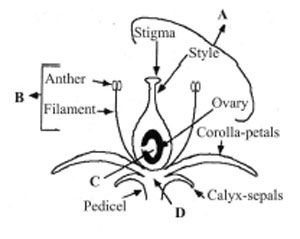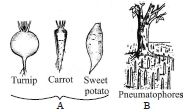The given figure shows the region of root tips with their region marked as A, B and C. Choose the option which shows the correct labelling of A, B and C.

A - Zone of elongation, B - Zone of meiosis, C - Zone of mitosis.
A - Zone of maturation, B - Zone of meristematic activity, C - Zone of elongation.
A - Zone of mitosis, B - Zone of elongation, C - Zone of root cap.
A - Region of maturation, B - Region of elongation, C - Zone of meristematic activity.
Correct Answer :
D. A - Region of maturation, B - Region of elongation, C - Zone of meristematic activity.
In the given figure, the root tip shows their different regions which are marked as A, B and C. The correct labelling of A, B and C are region of maturation, region of elongation and region of meristematic activity respectively.
Related Questions
Match the column-I containing types of aestivation with their examples given in column-II and choose the correct option.
| Column - I | Column-II |
|---|---|
| (Type of aestivation) | (Examples) |
| A. Valvate | I. Cotton |
| B. Twisted | II. Calotropis |
| C. Imbricate | III. Bean |
| D. Vexillary | IV. Gulmohar |
A I; B II; C IV; D III
A II; B I; C IV; D III
A II; B IV; C I; D III
A II; B I; C III; D IV
Alternate type of phyllotaxy is found in
china rose
mustard
sunflower
all of these
Match column I with column II and choose the correct combination from the options given below.
| (Position of floral parts on thalamus) | (Represented in) |
|---|---|
| A. Hypogynous | I. Ray florets of sunflower |
| B. Perigynous | II. Brinjal |
| C Epigynous | III Peach |
A II, B I, C III
A I, B II, C III
A III, B II, C I
A II, B III, C I
Which of the following represents the floral characters of liliaceae?
Six tepals, zygomorphic, six stamens, bilocular ovary, axile placentation.
Actinomorphic, polyphyllous, unilocular ovary, axile placentation.
Tricorpellary, actinomorphic, polyandrous, superior ovary, axile placentation.
Bisexual, zygomorphic, gamophyllous, inferior ovary, marginal placentation.
Match column-I with column-II and choose the correct option.
| A. Gram, sem, moong, | I. Medicine soyabean |
|---|---|
| B. Soyabean,groundnut | II. Ornamental |
| C. Indigofera | III. Fodder |
| D. Sunhemp | IV. Fibres |
| E. Sesbania, Trifolium | V. Dye |
| F. Lupin, sweet potato | VI. Edible oil |
| G. Mulethi | VII. Pulses |
A I, B II, C III, D IV, E V, F VI, G VII
A VII, B VI, C V, D IV, E III, F II, G I
A II, B IV, C VI, D I, E III, F V, G VII
A I, B III, C V, D VII, E II, F IV, G VI
During the post-fertilization period, the ovules develops into ___A____ and the ovary matures into a ___B ____.
A - seeds; B - fruit
A - fruit; B - seeds
A - flower; B - seed
A - seeds; B - flower
A - Which one of the option shows the correct labelling of the parts marked as A, B, C and D in a typical structure of dicotyledonous seeds ?

A - Hilum, B - Micropyle, C - Radicle, D - Cotyledon, E - Plumule
A - Hilum, B - Micropyle, C - Plumule, D - Cotyledon, E - Radicle
A - Micropyle, B - Hilum, C - Plumule, D - Cotyledon, E - Radicle
A - Hilum, B - Micropyle, C - Plumule, D - Radicle, E - Cotyledon
Most prominent function of inflorescence is
dispersal of seeds.
formation of more fruits.
formation of pollen grains.
dispersal of pollens.
Root hairs develop from
region of maturation
region of elongation
region of meristematic activity
root cap
Fibrous root system is better adopted than tap root system for
transport of organic matter.
absorption of water and minerals.
storage of food.
anchorage of plant to soil.
In flower (X), the gynoecium occupies the highest position while the other parts are situated below it. The ovary in such flowers is said to be Y. Identify X and Y and select the correct option.
X - Epigynous, Y - Inferior
X - Perigynous, Y - Superior
X - Hypogynous, Y - Superior
X - Perigynous, Y - Half-inferior
Pollen grains are produced within _________of stamen.
ovary
anther
filament
connective
The given figure shows the parts of mango and coconut. Choose the option which shows the correct labelling of A, B, C and D marked in the figures.

A - Epicarp, B - Mesocarp, C - Seed, D - Endocarp
A - Epicarp, B - Mesocarp, C - Ovule, D - Endocarp
A - Epicarp, B - Mesocarp, C - Ovary, D - Endocarp
A - Epicarp, B - Mesocarp, C - Embryo, D - Endocarp
Leaves of dicotyledonous plants possess _________ venation, while _________ venation is the characteristic of most monocotyledons.
reticulate and parallel
parallel and reticulate
reticulate and perpendicular
obliquely and parallel
Which of the following statement(s) is/are correct about venation?
(i) The arrangement of veins and the veinlets in the lamina of leaf is called venation.
(ii) Reticulate venation is the characteristic of monocots.
(iii) When the veinlets form a network, the venation is termed as reticulate venation.
(iv) When the veins run parallel to each other, within a lamina, the venation is termed as parallel venation.
Only (i)
Both (i) and (ii)
(i), (iii) and (iv)
All of these
Given figures (A, B and C) shows the position of floral parts on thalamus. (given as I, II and III) Select the correct combination.

- Hypogynous flower
- Perigynous flower
- Epigynous flower
A-I, B-II, C-III
A-I, B-III, C-II
A-III, B-II, C-I
A-III, B-I, C-II
Roots develop from parts of the plant other than radicle are called
tap roots
fibrous roots
adventitious roots
nodular roots
Which one of the following option shows the correct labelling of the structure marked as A, B, C & D?

A - Gynoecium, B - Megasporophyll, C - Ovule, D - Thalamus
A - Gynoecium, B - Stamen, C - Seed, D - Thalamus
A - Microsporophyll, B - Stamen, C - Ovule, D - Thalamus
A - Gynoecium, B - Stamen, C - Ovule, D - Thalamus
The region of the root-tip whose cells undergo rapid elongation and enlargement and are responsible for the growth of the root in length is called the
region of maturation.
region of elongation.
region of meristematic activity.
root-hairs.
Stilt roots occur in __________ .
groundnut
rice
sugarcane
wheat
Which of the following statements is correct?
Imbricate aestivation is found in papilionaceous family.
Generally sepals are green, leaf like and protect the flowers in the bud stage.
In cymose type of inflorescence, the main axis terminates in a flower, hence is limitless in growth.
In axile placentation ovary is one chambered but it becomes two cambered due to formation of the false septum.
Statement-1 : Ginger has a prostrate-growing rhizome.
Statement-2 : Shoot growth is not effected by gravity.
Statement-1 and statement-2 are true and Statement-2 is a correct explanation for statement-1.
Statement-1 and statement-2 are true but statement-2 is a correct explanation for statement-1.
Statement-1 is true and statement-2 is false.
Both the statements are false.
Which of the following part elongates directly and leads to the formation of primary roots?
bud
radicle
plumule
root hair
The given figures (A and B) shows the modificaiton of roots.Which of the following statements regarding the figures is correct ?

Tap roots of carrot, turnip and adventitious root of sweet potato, get swollen and store food.
Pneumatophores conducts water, minerals & photosynthesis
Pneumatophore is found in the plants that grow in sandy soil.
Turnip & carrot shows adventitious roots and sweet potato shows tap root.
Match column - I, II and III and choose the correct option.

A - V, t; B - II, s; C -I, r; D -III, q; E -IV, p
A - I, t; B - II, s; C - III, r; D - IV, p; E - V, q
A - V, p; B - II, s; C - I, q; D - III, r; E - IV, t
A - V, p; B - III, q; C - II, s; D - I, t; E - IV, r
Match the column I with column II and choose the option which shows their correct match.
| Column I | Column II |
|---|---|
| A. Placentation | (i) Arrangement of flowers on the rachis |
| B. Aestivation | (ii) Modified shoot for sexual reproduction |
| C. Inflorescence | (iii) Arrangement of various whorls in the bud |
| D. Flower | (iv) Arrangement of ovules within an ovary |
A - (i), B - (ii), C - (iii), D - (iv)
A - (iii), B - (i), C - (ii), D - (iv)
A - (iii), B - (i), C - (iv), D - (ii)
A - (iv), B - (iii), C - (i), D - (ii)
Cotyledons and testa respectively are edible parts in which of the following group?
walnut and tamarind
cashew nut and litchi
french bean and coconut
groundnut and pomegranate
Match the following placentation types given in column I with their examples given in column II and choose the correct combination from the options given below.
| (Placentation Types) | (Examples) |
|---|---|
| A. Basal | I. Dianthus |
| B. Free central | II. Pea |
| C. Parietal | III. Lemon |
| D. Axile | IV. Marigold |
| E. Marginal | V. Argemone |
A I, B II, C III, D IV, E V
A II, B III, C IV, D V, E I
A IV, B I, C V, D III, E II
A IV, B III, C V, D I, E II
Identify the correct families of the given plant species (A, B and C)

A - Liliaceae, B - Compositae, C - Malvaceae
A - Fabaceae, B - Solanaceae, C - Liliaceae
A - Compositae, B - Malvaceae, C - Liliaceae
A - Solanaceae, B - Fabaceae, C - Liliaceae
The X is small and situated in a groove at one end of the endosperm. It consists of one large and shield shaped cotyledon known as Y and a short axis with a plumule and a Z. Identify X, Y and Z.
X - Scutellum, Y - Embryo, Z - Radicle
X - Embryo, Y - Scutellum, Z - Radicle
X - Scutellum, Y - Radicle, Z - Embryo
X - Radicle, Y - Embryo, Z - Scutellum
